Basics of the combat system in games
Dear readers, I have come up with an interesting hobby for myself that will bring tangible benefits not only to me, but also to you. Since now I am actively engaged in upgrading my skills in creating games, I have to learn tons of various information on this topic, and a lot of useful information can be found only in the burzhnet. I myself do not like to read information in a language that is not my own, so I decided to kill a whole flock of hares right away: improve my language by translating articles, improve my skills as a game designer, benefit others by sharing interesting material. They drove.
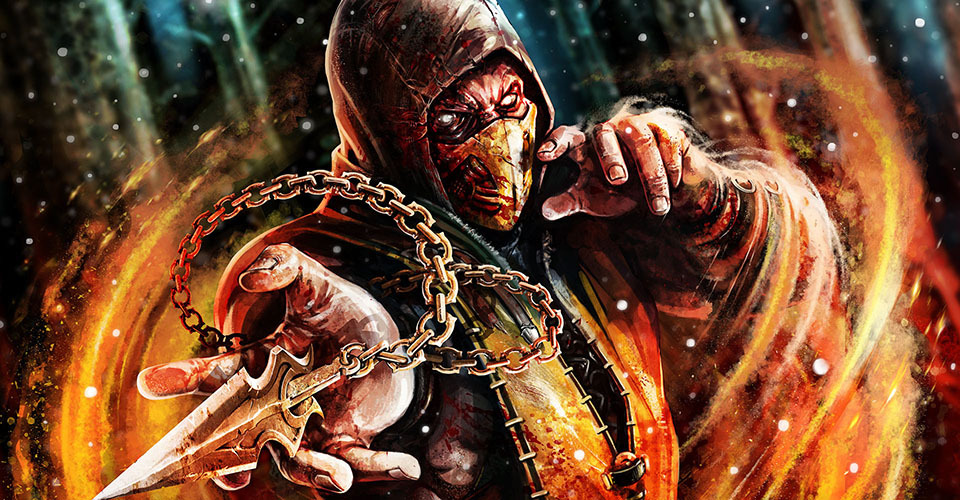
Many game designers periodically practice developing a combat system. I got into a difficult time when I had to do it for the first time. My experience at the time left much to be desired, and useful information from experienced game designers was almost impossible to find.
')
As a result, thanks to the experience gained, it was possible to write a set of rules. Compliance with the rules will help you to translate a powerful combat mechanics in your games.
The most important thing to always remember is that the player must perform the right actions and use the right skills at the right time. The player must anticipate upcoming events and build their battle tactics.
Among the variety of options for achieving our goals, I highlight two key characteristics:
Let's dive deeper into these characteristics on the example of the game Call of Duty.
1. Each skill has its own unique function.
If you try to say differently, then each skill is a kind of tool for the player. In the diagram below, you can see the set of abilities and their range of influence.

Imagine the variety of options to “press the right button at the right time” arises for the player, taking into account the use of any of these abilities at any given time.
But these are just flowers. Our main goal is to make the player need to come up with his own tactics during the battle. See how much you can do, but carefully assess the current situation of the friend and choose the best option.
2. Risk vs reward. Compromise for every skill.
In addition to individual characteristics, each skill has its own advantages and disadvantages. Let's explore this by the example of the Street Fighter II fighting game.

There are many advantages and trade-offs that a game designer can build into a certain skill.
Here is an example of frequently used action games:
Advantages: damage, stunning, push, prolonged damage, blinding, regeneration.
Compromises: consumable units, recharge, activation time, recovery time.
Even if each ability is perfectly balanced by a game designer, it will be mega cool if the player can decide for himself how much he wants to take the risk to get the maximum benefit. Some shots can do light damage without much risk, because they are fast. Super-blows can cause heavy damage, but there is a risk of overshooting due to speed.

Some skills allow you not only to attack your opponent, but also to make counterattacks. Therefore, using the skill at the wrong moment leads to misses or, worse, loss of HP. A counterattack is also a certain risk that a player assumes.
Three tasks.
In modern action games, the action takes place in real time, so the player must constantly evaluate the various parameters of the current situation and make decisions regarding the abilities to be used.
Distance estimate
Time evaluation
Ingenuity and premonition
One of the main goals of the presence of enemies in the game is the gradual training of the player to the mechanics of the game each time creating interesting tasks.
The rival is a challenge for the player.
If you create artificial intelligence in a game, try to bring its behavior closer to a living person. For example, in order for a player to get a truly unforgettable experience, you must give him enemies who behave like a team and perform reasonable actions.
Do not forget that most of all the gaming experience is affected not by the clever behavior of the opponent, but by the task created for the player. First of all, you should start from the right task and after that give the appropriate properties to the opponent's artificial intelligence.
Determine the exact task for each opponent. The main function of the opponent is to attack the player, and since the player destroys his enemies for most of the playing time, I ask myself two key questions when designing their behavior:
When you need to think over a whole bunch of different rivals, we try to create different ways to defeat each of them. Here are a couple of examples from the game Spider-man :

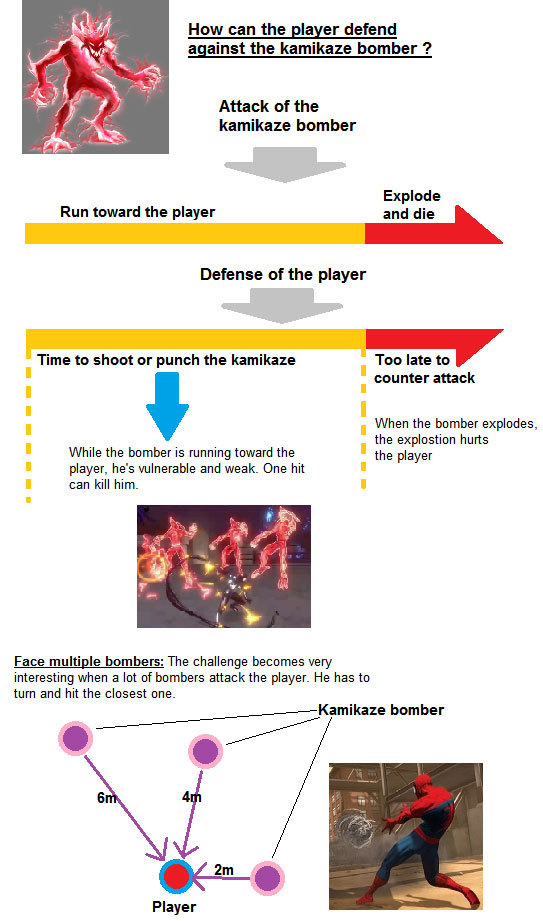
As you can see from the examples, different opponents offer different tasks for the player when he has to defend against them:
Player skills
In addition to thinking through different tasks for each opponent it is very interesting to think over the weaknesses of enemies against a particular weapon. It is necessary to think over the functions of each weapon in order to be more or less effective against different opponents. That's why all this is needed:
An example from the Halo game that illustrates this:

Due to different properties, in the course of the fight against different types of enemies, the player can switch from one ability to another in order to be more effective in battle.
The main archetypes of the enemies in the games of the genre of action
Since everyone wants to have enemies that match the player’s abilities, we often see the same types of opponents in different games. However, there are many advantages in using common archetypes:
Here is a list of the most common archetypes in action games:
Subclasses and variations of archetypes.
In addition to our desire to classify enemies, we also want to add more diversity to add interesting tasks throughout the game.
The main task of the subclasses is to push the player to limit the combat system. Playing according to the rules familiar to him, add new abilities to enemies that force the player to upgrade other skills. Prior to this, the main thing was to respond quickly, and now we must also be precise.
It’s good if, when creating opponents, we analyze the advantageous properties and complicating features of each opponent.
Advantageous properties of the enemy will allow the player to use them to cause damage to other opponents.
Complicating features of the enemy will complicate the task of killing him.
Let's see how this works with the example of Mario:
Here is the usual archetype of the enemy

But the subclass of the enemy archetype

Subclassing is a very good way to increase or decrease the complexity of a class without breaking the general rules for identifying it.
An example of risk and reward management:
For a variety of combat strategies, we can add subclasses and benefits and complications to a specific enemy.
For example, there is an enemy with a shield and a weak area on the back. If a player hits it several times, the opponent will explode.
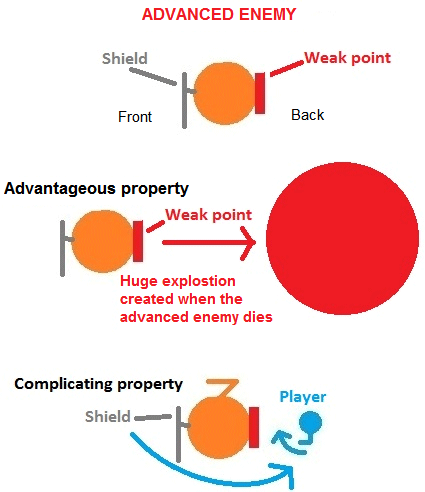
Thanks to the shield of the enemy is more difficult to kill, because the player must shoot in a circle. But we added a weak spot on the back to give the player new tactical possibilities. Usually, the player will try to kill the weakest enemy first of all, in order to reduce the number of living enemies as quickly as possible, but in this case ...

An additional risk for the player is to try to kill the reinforced opponent while the others are alive. At the same time, the player can take advantage of the weak zone and kill the entire group faster. Now solely depends on him the management of risks and rewards, depending on what he wants to achieve.

Many game designers periodically practice developing a combat system. I got into a difficult time when I had to do it for the first time. My experience at the time left much to be desired, and useful information from experienced game designers was almost impossible to find.
')
As a result, thanks to the experience gained, it was possible to write a set of rules. Compliance with the rules will help you to translate a powerful combat mechanics in your games.
The most important thing to always remember is that the player must perform the right actions and use the right skills at the right time. The player must anticipate upcoming events and build their battle tactics.
Among the variety of options for achieving our goals, I highlight two key characteristics:
- Each skill has its own unique function: to stun an opponent, click here.
- The balance of skills in terms of risk-benefit.
Let's dive deeper into these characteristics on the example of the game Call of Duty.
1. Each skill has its own unique function.
If you try to say differently, then each skill is a kind of tool for the player. In the diagram below, you can see the set of abilities and their range of influence.

- Close fight Covers the area in front of the player at close range. Can only be used at close range, but kills with one blow.
- Normal shot. Basic, often used at any time player skill. Best used at medium range.
- Shooting with a sight. Ideal for accurate head shots over long distances. It is dangerous to use because of the loss of the benefits of peripheral vision.
- Grenade. The ideal weapon for injuring enemies who hide behind obstacles. Kills with one blow, but due to the small amount you need to try to choose the most suitable moment for a throw.
Imagine the variety of options to “press the right button at the right time” arises for the player, taking into account the use of any of these abilities at any given time.
But these are just flowers. Our main goal is to make the player need to come up with his own tactics during the battle. See how much you can do, but carefully assess the current situation of the friend and choose the best option.
2. Risk vs reward. Compromise for every skill.
In addition to individual characteristics, each skill has its own advantages and disadvantages. Let's explore this by the example of the Street Fighter II fighting game.

There are many advantages and trade-offs that a game designer can build into a certain skill.
Here is an example of frequently used action games:
Advantages: damage, stunning, push, prolonged damage, blinding, regeneration.
Compromises: consumable units, recharge, activation time, recovery time.
Even if each ability is perfectly balanced by a game designer, it will be mega cool if the player can decide for himself how much he wants to take the risk to get the maximum benefit. Some shots can do light damage without much risk, because they are fast. Super-blows can cause heavy damage, but there is a risk of overshooting due to speed.

Some skills allow you not only to attack your opponent, but also to make counterattacks. Therefore, using the skill at the wrong moment leads to misses or, worse, loss of HP. A counterattack is also a certain risk that a player assumes.
Three tasks.
In modern action games, the action takes place in real time, so the player must constantly evaluate the various parameters of the current situation and make decisions regarding the abilities to be used.
Distance estimate
- It is necessary to estimate the distance to the target to determine the ability.
- It is necessary to predict the location of the character after using the ability.
Time evaluation
- The time required to complete the ability.
- Anticipate the duration of the ability.
Ingenuity and premonition
- It is necessary to anticipate the sequence of actions in different situations.
- Know what abilities to use to repel an opponent's attack.
One of the main goals of the presence of enemies in the game is the gradual training of the player to the mechanics of the game each time creating interesting tasks.
The rival is a challenge for the player.
If you create artificial intelligence in a game, try to bring its behavior closer to a living person. For example, in order for a player to get a truly unforgettable experience, you must give him enemies who behave like a team and perform reasonable actions.
Do not forget that most of all the gaming experience is affected not by the clever behavior of the opponent, but by the task created for the player. First of all, you should start from the right task and after that give the appropriate properties to the opponent's artificial intelligence.
Determine the exact task for each opponent. The main function of the opponent is to attack the player, and since the player destroys his enemies for most of the playing time, I ask myself two key questions when designing their behavior:
- How can a player attack and destroy an enemy?
- How can a player defend against an enemy attack?
When you need to think over a whole bunch of different rivals, we try to create different ways to defeat each of them. Here are a couple of examples from the game Spider-man :


As you can see from the examples, different opponents offer different tasks for the player when he has to defend against them:
- The best ability of the player to protect against ninja is to dodge. The main task for the player is to use timings correctly.
- The best ability of a player to protect against kamikazes is to shoot with cobwebs. The main task for the player is to correctly estimate the distance.
Player skills
In addition to thinking through different tasks for each opponent it is very interesting to think over the weaknesses of enemies against a particular weapon. It is necessary to think over the functions of each weapon in order to be more or less effective against different opponents. That's why all this is needed:
- Pushes the player to use all the features that he has.
- Helps the player to learn the features of each weapon.
- Pushes the player to form their own tactics when using abilities.
An example from the Halo game that illustrates this:

Due to different properties, in the course of the fight against different types of enemies, the player can switch from one ability to another in order to be more effective in battle.
The main archetypes of the enemies in the games of the genre of action
Since everyone wants to have enemies that match the player’s abilities, we often see the same types of opponents in different games. However, there are many advantages in using common archetypes:
- They offer to solve an easy-to-understand problem.
- They are easily recognizable.
- The player understands without additional instructions how to overcome them.
Here is a list of the most common archetypes in action games:
- Enemy with shield: challenge for your accuracy.

- Tank: need a powerful attack or weapon to destroy.
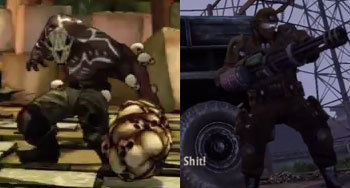
- Sniper: Attack in the distance to hit.
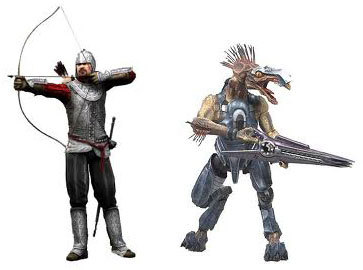
- Demoman: melee with a time limit.

Subclasses and variations of archetypes.
In addition to our desire to classify enemies, we also want to add more diversity to add interesting tasks throughout the game.
The main task of the subclasses is to push the player to limit the combat system. Playing according to the rules familiar to him, add new abilities to enemies that force the player to upgrade other skills. Prior to this, the main thing was to respond quickly, and now we must also be precise.
It’s good if, when creating opponents, we analyze the advantageous properties and complicating features of each opponent.
Advantageous properties of the enemy will allow the player to use them to cause damage to other opponents.
Complicating features of the enemy will complicate the task of killing him.
Let's see how this works with the example of Mario:
Here is the usual archetype of the enemy

- He simply patrols the route and moves towards the player.
- You need to jump on him to overcome.
- As a result, his shell can be used to kill other enemies.
But the subclass of the enemy archetype

- He simply patrols the route and moves towards the player.
- It can move through the air (a complicating feature).
- As a result, his shell can be used to kill other enemies.
Subclassing is a very good way to increase or decrease the complexity of a class without breaking the general rules for identifying it.
An example of risk and reward management:
For a variety of combat strategies, we can add subclasses and benefits and complications to a specific enemy.
For example, there is an enemy with a shield and a weak area on the back. If a player hits it several times, the opponent will explode.

Thanks to the shield of the enemy is more difficult to kill, because the player must shoot in a circle. But we added a weak spot on the back to give the player new tactical possibilities. Usually, the player will try to kill the weakest enemy first of all, in order to reduce the number of living enemies as quickly as possible, but in this case ...

An additional risk for the player is to try to kill the reinforced opponent while the others are alive. At the same time, the player can take advantage of the weak zone and kill the entire group faster. Now solely depends on him the management of risks and rewards, depending on what he wants to achieve.
Source: https://habr.com/ru/post/253697/
All Articles